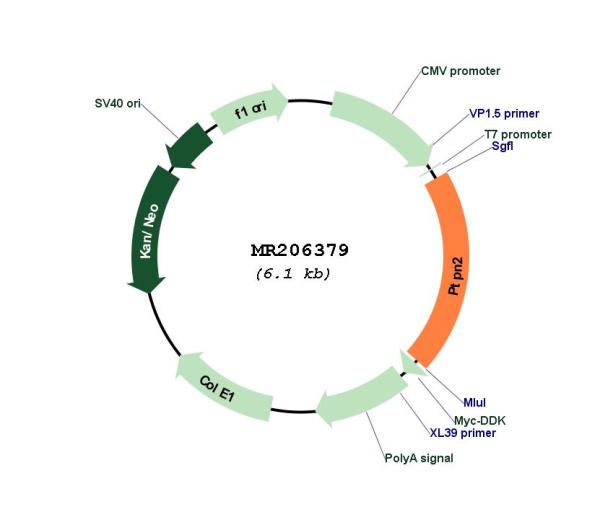Ptpn2 (NM_001127177) Mouse Tagged ORF Clone
CAT#: MR206379
- TrueORF®
Ptpn2 (Myc-DDK-tagged) - Mouse protein tyrosine phosphatase, non-receptor type 2 (Ptpn2), transcript variant 2
Lentiviral Particles: DDK w/ Puro mGFP w/ Puro
AAV Particle: DDK
"NM_001127177" in other vectors (2)
Interest in protein/lysate? Submit request here!
USD 198.00
Specifications
| Product Data | |
| Type | Mouse Tagged ORF Clone |
| Tag | Myc-DDK |
| Symbol | Ptpn2 |
| Synonyms | AI325124; Ptpt; TC-PTP |
| Vector | pCMV6-Entry |
| E. coli Selection | Kanamycin (25 ug/mL) |
| Mammalian Cell Selection | Neomycin |
| Sequence Data |
>MR206379 ORF sequence
Red=Cloning site Blue=ORF Green=Tags(s) TTTTGTAATACGACTCACTATAGGGCGGCCGGGAATTCGTCGACTGGATCCGGTACCGAGGAGATCTGCC GCCGCGATCGCC ATGTCGGCAACCATCGAGCGGGAGTTCGAGGAACTGGATGCTCAGTGTCGCTGGCAGCCGTTATACTTGG AAATTCGAAATGAATCCCATGACTATCCTCATAGAGTGGCCAAGTTTCCAGAAAACAGAAACCGAAACAG ATACAGAGATGTAAGCCCATATGATCACAGTCGTGTTAAACTGCAAAGTACTGAAAATGATTATATTAAT GCCAGCTTAGTTGACATAGAAGAGGCACAAAGAAGTTACATCTTAACACAGGGCCCACTTCCGAACACAT GCTGCCATTTCTGGCTCATGGTGTGGCAGCAAAAGACCAAAGCAGTTGTCATGCTAAACCGAACTGTAGA AAAAGAATCGGTTAAATGTGCACAGTACTGGCCAACGGATGACAGAGAAATGGTGTTTAAGGAAACGGGA TTCAGTGTGAAGCTCTTATCTGAAGATGTAAAATCATATTATACAGTACATCTACTACAGTTAGAAAATA TCAATACTGGTGAAACCAGAACCATATCTCACTTCCATTATACCACCTGGCCAGATTTTGGGGTTCCAGA GTCACCAGCTTCATTTCTAAACTTCTTGTTTAAAGTTAGAGAATCTGGTTGTTTGACCCCTGACCATGGA CCTGCAGTGATCCATTGCAGTGCGGGCATCGGGCGCTCTGGCACCTTCTCTCTTGTAGATACCTGTCTTG TTCTGATGGAAAAAGGAGAGGATGTTAATGTGAAACAATTATTACTGAATATGAGAAAGTATCGAATGGG ACTTATTCAGACACCGGACCAACTCAGATTCTCCTACATGGCCATAATAGAAGGAGCAAAGTACACAAAA GGAGATTCAAATATACAGAAACGGTGGAAAGAACTTTCTAAAGAAGATTTATCTCCTATTTGTGATCATT CACAGAACAGAGTGATGGTTGAGAAGTACAATGGGAAGAGAATAGGTTCAGAAGATGAAAAGTTAACAGG GCTTCCTTCTAAGGTGCAGGATACTGTGGAGGAGAGCAGTGAGAGCATTCTACGGAAACGTATTCGAGAG GATAGAAAGGCTACGACGGCTCAGAAGGTGCAGCAGATGAAACAGAGGCTAAATGAAACTGAACGAAAAA GAAAAAGGTGGTTATATTGGCAACCTATTCTCACTAAGATGGGGTTTGTGTCAGTCATTTTGGTTGGCGC TTTGGTTGGCTGGACACTGCTTTTTCAC ACGCGTACGCGGCCGCTCGAGCAGAAACTCATCTCAGAAGAGGATCTGGCAGCAAATGATATCCTGGATT ACAAGGATGACGACGATAAGGTTTAA >MR206379 protein sequence
Red=Cloning site Green=Tags(s) MSATIEREFEELDAQCRWQPLYLEIRNESHDYPHRVAKFPENRNRNRYRDVSPYDHSRVKLQSTENDYIN ASLVDIEEAQRSYILTQGPLPNTCCHFWLMVWQQKTKAVVMLNRTVEKESVKCAQYWPTDDREMVFKETG FSVKLLSEDVKSYYTVHLLQLENINTGETRTISHFHYTTWPDFGVPESPASFLNFLFKVRESGCLTPDHG PAVIHCSAGIGRSGTFSLVDTCLVLMEKGEDVNVKQLLLNMRKYRMGLIQTPDQLRFSYMAIIEGAKYTK GDSNIQKRWKELSKEDLSPICDHSQNRVMVEKYNGKRIGSEDEKLTGLPSKVQDTVEESSESILRKRIRE DRKATTAQKVQQMKQRLNETERKRKRWLYWQPILTKMGFVSVILVGALVGWTLLFH TRTRPLEQKLISEEDLAANDILDYKDDDDKV |
| Restriction Sites |
SgfI-MluI
Cloning Scheme for this gene
Plasmid Map

|
| ACCN | NM_001127177 |
| ORF Size | 1221 bp |
| OTI Disclaimer | The molecular sequence of this clone aligns with the gene accession number as a point of reference only. However, individual transcript sequences of the same gene can differ through naturally occurring variations (e.g. polymorphisms), each with its own valid existence. This clone is substantially in agreement with the reference, but a complete review of all prevailing variants is recommended prior to use. More info |
| OTI Annotation | This clone was engineered to express the complete ORF with an expression tag. Expression varies depending on the nature of the gene. |
| Product Components | The ORF clone is ion-exchange column purified and shipped in a 2D barcoded Matrix tube containing 10ug of transfection-ready, dried plasmid DNA (reconstitute with 100 ul of water). |
| Reconstitution | 1. Centrifuge at 5,000xg for 5min. 2. Carefully open the tube and add 100ul of sterile water to dissolve the DNA. 3. Close the tube and incubate for 10 minutes at room temperature. 4. Briefly vortex the tube and then do a quick spin (less than 5000xg) to concentrate the liquid at the bottom. 5. Store the suspended plasmid at -20°C. The DNA is stable for at least one year from date of shipping when stored at -20°C. |
| Reference Data | |
| RefSeq | NM_001127177.1, NP_001120649.1 |
| RefSeq Size | 8423 bp |
| RefSeq ORF | 1221 bp |
| Locus ID | 19255 |
| UniProt ID | Q06180 |
| Cytogenetics | 18 E1 |
| MW | 47.4 kDa |
| Gene Summary | Non-receptor type tyrosine-specific phosphatase that dephosphorylates receptor protein tyrosine kinases including INSR, EGFR, CSF1R, PDGFR. Also dephosphorylates non-receptor protein tyrosine kinases like JAK1, JAK2, JAK3, Src family kinases, STAT1, STAT3 and STAT6 either in the nucleus or the cytoplasm. Negatively regulates numerous signaling pathways and biological processes like hematopoiesis, inflammatory response, cell proliferation and differentiation, and glucose homeostasis. Plays a multifaceted and important role in the development of the immune system. Functions in T-cell receptor signaling through dephosphorylation of FYN and LCK to control T-cells differentiation and activation. Dephosphorylates CSF1R, negatively regulating its downstream signaling and macrophage differentiation. Negatively regulates cytokine (IL2/interleukin-2 and interferon)-mediated signaling through dephosphorylation of the cytoplasmic kinases JAK1, JAK3 and their substrate STAT1, that propagate signaling downstream of the cytokine receptors. Also regulates the IL6/interleukin-6 and IL4/interleukin-4 cytokine signaling through dephosphorylation of STAT3 and STAT6 respectively. In addition to the immune system, it is involved in anchorage-dependent, negative regulation of EGF-stimulated cell growth. Activated by the integrin ITGA1/ITGB1, it dephosphorylates EGFR and negatively regulates EGF signaling. Dephosphorylates PDGFRB and negatively regulates platelet-derived growth factor receptor-beta signaling pathway and therefore cell proliferation. Negatively regulates tumor necrosis factor-mediated signaling downstream via MAPK through SRC dephosphorylation. May also regulate the hepatocyte growth factor receptor signaling pathway through dephosphorylation of the hepatocyte growth factor receptor MET. Plays also an important role in glucose homeostasis. For instance, negatively regulates the insulin receptor signaling pathway through the dephosphorylation of INSR and control gluconeogenesis and liver glucose production through negative regulation of the IL6 signaling pathways. May also bind DNA.[UniProtKB/Swiss-Prot Function] |
Documents
| Product Manuals |
| FAQs |
| SDS |
Resources
Other Versions
| SKU | Description | Size | Price |
|---|---|---|---|
| MR206379L3 | Lenti ORF clone of Ptpn2 (Myc-DDK-tagged) - Mouse protein tyrosine phosphatase, non-receptor type 2 (Ptpn2), transcript variant 2 |
USD 757.00 |
|
| MR206379L4 | Lenti ORF clone of Ptpn2 (mGFP-tagged) - Mouse protein tyrosine phosphatase, non-receptor type 2 (Ptpn2), transcript variant 2 |
USD 757.00 |
{0} Product Review(s)
Be the first one to submit a review






























































































































































































































































 Germany
Germany
 Japan
Japan
 United Kingdom
United Kingdom
 China
China


